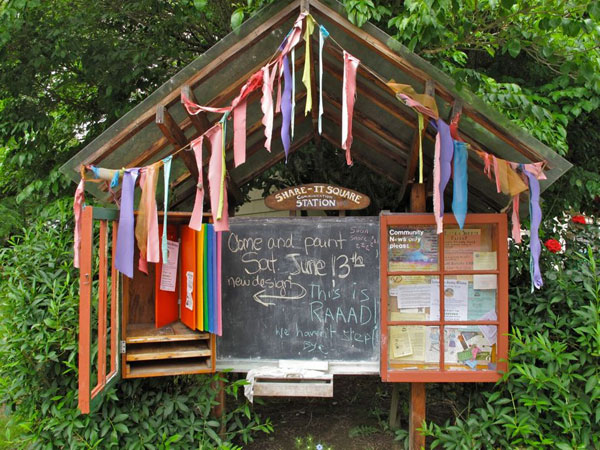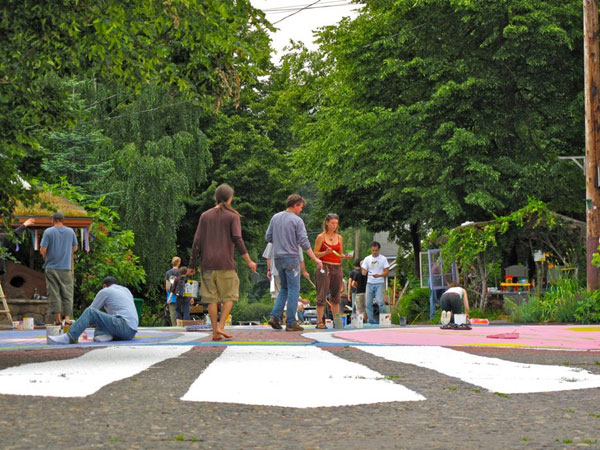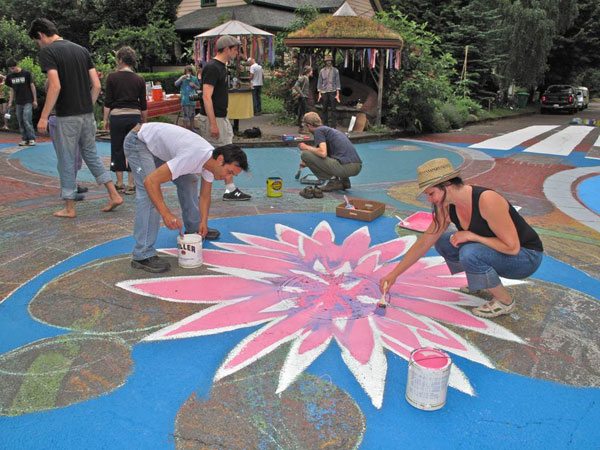[Editor's note: When thinking of Vancouver's grid-patterned streets, "prison," "colonization" and "hegemony" may not be the first words that come to mind -- but that's exactly what the Romans and Assyrians had in mind when they built cities this way millennia ago. While conventional urban planning certainly prefers grids to suburban sprawl, Vancouver author Charles Montgomery makes a case for more "crowd-sourced" neighbourhood-building in this passage of his new book, Happy City. Reprinted with permission from Doubleday Canada, the following excerpt looks to a small Portland neighbourhood as a guiding example of happy urban design.]
If you had driven through Sellwood in the late 1980s, you might have noticed a tall young man with an unruly shock of black hair sullenly mowing the lawn in front of a farm-style house on Southeast Ninth Avenue. That would be Mark Lakeman. He had lived there most of his life, and he was desperately unhappy. His malaise matched that of his neighbourhood. With its modest lots and treelined streets, Sellwood approximated the streetcar suburb sweet spot, yet it was the kind of place where you could walk the sidewalks and never meet anyone. Most people drove when they had to go anywhere. The streets were empty of children and, not coincidentally, full of cars cutting through on their way downtown from distant suburbs. Lakeman couldn't extinguish his feelings of disconnection. Trained as an architect and steeped in the culture of design, he had a hunch that something was broken in the shape of his neighbourhood, but he couldn't put a finger on what it was.
When he was 27, Lakeman quit his corporate architectural job and went searching for the solution to his unhappiness. The quest was personal, but it was also architectural. You might say he was searching for what the architect-philosopher Christopher Alexander once called "the quality without a name," a sense of aliveness in the city, and in himself.
Lakeman took a plane across the Atlantic. He visited the ruins of meeting places built by his Celtic ancestors, circles of stone now sinking into the heather of England's Lake District. He studied the daily rhythm of light and human activity in the piazzas of the Tuscan hill towns, and he was as moved by them as Jan Gehl had been 30 years before. Finally, after three continents and years of searching, he ventured into the lowland rain forests near Mexico's frontier with Guatemala. The region is home to the Lacandon, a people whose ancestors resisted the Spanish conquest and who still live beyond the reach of modern urban planners.
Lakeman found the quality he was looking for in an unpaved village called Naja. It was hardly a romantic scene. The villagers cooked on earthen hearths and built their huts from rough-hewn mahogany. Lakeman was moved by the richness of their lives and the way it was reflected in the form of their settlement. The place was constantly being redesigned for reasons of pragmatism or imagination. The Lacondon would meet at the merging dirt pathways between their homes and gardens, and those intersections would gradually flatten and widen into gathering spaces. When they gathered, they would gather in circles. As conversations merged, circles would merge and grow. Those shapes reflected the intimate political and social dynamic in the village. Everyone participated on this earthen agora. There was no separation between children and adults.
Over months, Lakeman befriended the village leader, Chan K'in Viejo, an ancient man with a deeply crevassed face, two wives, and 21 children. In the smoky shadows of the leader's hut, Lakeman admitted that it was not until he entered Naja that he was able to extinguish his feelings of disconnection. This was the first time he had seen a community of people actually behaving like a community: gathering, talking, and helping one another every day. It would have been nice to stay, he said. The old man told him to go home and fix his own village.
Grid hegemony
When he returned to Portland, Lakeman recognized what might have been the heart of his village, buried under asphalt right there at the intersection of Southeast Sherrett Street and Ninth Avenue. "Why didn't people in Sellwood know each other's names or talk to each other or meet each other?" Lakeman recalled later. "Why didn't they behave like villagers? I realized that part of the answer was in design." In that straight, empty street grid he saw a kind of institutionalized, village-killing prison -- the opposite of Naja's convivial circles.
Lakeman's reaction to the street grid might seem melodramatic, but history supports his framing. The orthogonal road grid that defined Sellwood -- and most North American cities -- really is a hand-me-down from empires who used streets as tools of aggression.
The Assyrians used the grid design for garrisons and detention camps in conquered regions. So did the Romans. The rectilinear lines of their garrison towns, and eventually their basilicas, ran right over the circular gathering spaces of Lakeman's ancestors in northern England. Thomas Jefferson convinced his fellow Founding Fathers of the American republic to adopt the Roman grid barely four years after their victory against the British Empire. The national Land Ordinance of 1785 set the grid as the approved form for all settlements west of the Ohio River. It was part of the tool kit of colonization and nation building.
The grid was the fastest, simplest way to divide land so that it could be commodified. Rectangular units were easy to survey, buy, sell, and tax. They made it easier to provide services. The grid was a spectacular success as an economic tool, but it created some seriously unbalanced cities. The Land Ordinance of 1785 did not have provisions for parks or open space. Its cities comprised private lots and public roads, as though the city existed purely for commerce rather than for the people that commerce was thought to enrich. In town after town, planners subdivided, overlooked, or avoided public parks and plazas. Cities that wanted parks actually had to buy the land from private holders.
The result was that in most neighbourhoods, the streets themselves became the only shared public space. As they came to be dominated by cars, the public living room -- and the village that might have been born within it -- disappeared.
The grid has its defenders, especially when compared with the stunning inefficiency of the freeway and cul-de-sac development of sprawl. New Urbanists admire the clarity and connectivity that can make grid neighbourhoods so conducive to walking. Traffic engineers point out that a tight grid of arterial roads is less vulnerable to the nightmarish delays that accidents can cause on dendritic systems and freeways.
But the imposition of the grid or any other plan from on high has another, ultimately more profound effect on the people who must inhabit it: it estranges them from the process of shaping their own world.
"None of the people who have ever lived on my street had a say on how it was laid out. None of them ever held a vote and said, 'Let's make this bilaterally symmetrical, and let's make the rules on this side of the street the same as on the other side of the street. Let's make sure the intersections won't be the gathering places that our ancestors made back in the lands that we came from,'" Lakeman told me. "How many of us actually said, 'Hey, let's not have even one public square in the typical American neighbourhood,' where in the typical village there were many."
Whether or not you share Lakeman's conception of the evils of the urban grid, he does identify that great irony of the American city: a nation that celebrates freedom and weaves liberty into its national myth rarely gives regular people the chance to shape their own communities. Municipal governments, often with the counsel and assistance of land developers, lay down community plans complete with restrictive zoning long before residents arrive on the scene. Residents have no say about what their streets and parks and gathering places will look like. And once they move in, it is illegal for them to tinker with the shape of the public places they share, or, as I have illustrated, to use their homes for anything beyond the dictates of strict zoning bylaws.
Most people in wealthy cities do not make their own homes or neighbourhoods. They simply decorate and inhabit the dwellings they are offered. And we know that the ultimate villageless city -- sprawl -- has effectively sapped its residents of social and political wherewithal. As I have shown, people who live in sprawl are among the least likely of Americans to volunteer, vote, join political parties, or rise up and raise hell. There are many reasons for this apathy; not least among them might be genuine contentment. But the fact is, it's hard to find the agora in the dispersed city. You can't hold a demonstration in a Walmart parking lot or inside a Starbucks. Scant few neighbourhoods in North America feature places that draw people together regularly for anything other than buying stuff.
Sellwood spring
This is why what happened when Lakeman got back to Sellwood that spring was so revolutionary. He challenged his neighbours to take control of the shape of their community.
First, Lakeman and a few friends built a ramshackle teahouse of salvaged wood and old windows around the base of an old tree on his parents' property on the corner of the intersection of Southeast Sherrett and Southeast Ninth, and they invited the neighbours to come for tea. Sellwood had never seen anything like it. Curious, people from up and down the blocks popped in. As spring grew lush and the cottonwood seeds began to fly in the breeze, a few dozen people would arrive to share Monday-night potluck dinners. By summer, there were hundreds.
The neighbours got to talking about the state of their neighbourhood: the commuters who roared through the grid on their way to the Sellwood Bridge, the kids who had been struck by cars while trying to reach a nearby park, and the fact that none of them had ever talked to each other before. To Lakeman's delight, one Monday evening the crowd pushed right out into the middle of the intersection, and the cars stopped, and some of the people started to dance in the warm evening air.
When Portland's Bureau of Buildings ordered the teahouse, an unauthorized structure, torn down, the neighbours looked to the intersection and imagined a village square that was as desirable as it was forbidden.
The way that neighbours remember it now, someone's kid, a girl of 13, gathered the other children around a map of the four blocks around the intersection. The kids drew lines on that map with red felt-tip pens, connecting neighbours. There was a chef, and lots of people who liked to eat. There was a social worker, and people who had social problems. There was a musician, and people who liked music. There was an electrician. A plumber. A roofer. A designer. A landscaper. A carpenter. A contractor. Then they added the stay-at-home parents and the kids, too.
Eventually the map was so criss-crossed with red it was hard to read. All these people drove out of the neighbourhood to eat, to socialize, to work, and to spend. "We realized that we had a full-on village right here," Lakeman said. "All we were missing was a central place to connect." In other words, the neighbourhood did not have a human resources problem. It had a design problem.
The neighbours gathered one weekend in September, 30 of them, and they brought paint, and they coated the asphalt in concentric circles radiating from the manhole at its centre so that all four corners were linked. From then on, the intersection would be a piazza. They called it Share-It-Square.

Portland's Office of Transportation promptly threatened to fine the neighbours and sandblast the circles off the street. The intersection was a public space. "That means nobody is allowed to use it!" one city staffer infamously declared.
But Lakeman charmed city councillors with his village tales. The mayor pulled rank on the city's engineers. Within a few weeks the square had a conditional permit.
The neighbours built a telephone booth-size library on one corner of the intersection so people could come and trade books. They built a message board and chalk stand on the northeast corner, and a produce-sharing stand on the southeast, and a kiosk on the south-west with a big thermos that they agreed to keep full of hot tea.
Eventually the lines between public and private space began to blur. Just as the neighbours had appropriated the public right-of-way, so they began to open their own lots. One couple built a community sauna in their backyard. Fences between yards came down. People from blocks away came to help themselves to vegetables from the produce stand -- and leave other greens in their place. People went out of their way to help one another. One elderly woman left town for a week and returned to find that her neighbours had painted the peeling exterior of her house.
I visited Portland on the spring day when the piazza was getting its annual new coat of paint. There were cans and brushes and kids all over the street, smearing the asphalt with coats of electric pink, turquoise, and leaf green. There was Wayne, a homeless bottle collector, pausing for a smoke and a chat on the cob bench the villagers had built, with Pedro Ferbel, the guy who built a community sauna in his backyard. A young mother put down her paint roller and told me that she had moved nearby for the sake of her daughter, who had met most of her friends around this intersection. Betty Beals, a woman with long gray hair, poured me a cup of tea from the thermos at the covered kiosk and told me how she once felt scared to walk these streets because she just didn't recognize or trust the people she encountered. Not anymore.

Other people spoke of spending less money than they used to -- they borrowed tools from friends, for example, and were more likely to host neighbours for dinner rather than going out. This was partly a result of the financial crisis that had hit the country so hard, but it would not have happened if the door of conviviality had not been opened.
Excerpted from Happy City. Copyright © 2013 Charles Montgomery. Published by Doubleday Canada, an imprint of the McClelland Doubleday Canada Publishing Group, which is a division of Random House of Canada Limited. Reproduced by arrangement with the publisher. All rights reserved. ![]()
Read more: Urban Planning + Architecture















Tyee Commenting Guidelines
Comments that violate guidelines risk being deleted, and violations may result in a temporary or permanent user ban. Maintain the spirit of good conversation to stay in the discussion.
*Please note The Tyee is not a forum for spreading misinformation about COVID-19, denying its existence or minimizing its risk to public health.
Do:
Do not: